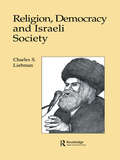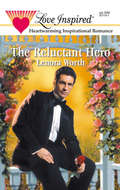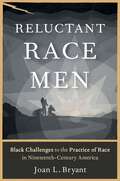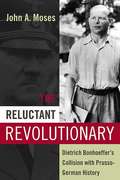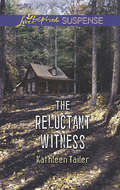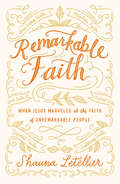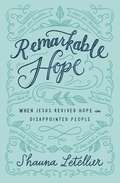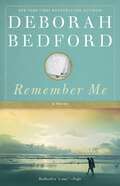- Table View
- List View
Relign Democrcy & Israeli Soc
by LiebmanFirst Published in 1997. Routledge is an imprint of Taylor & Francis, an informa company.
Reliquary of the Holy Thorn (Tactile)
by RnibParis, France; about 1390-97; gold, enamel, rock-crystal, pearls, rubies, and sapphires; about 30 cm high by 14 cm wide and 7 cm deep. Jean duc de Berry, the brother of Charles V of France, commissioned this opulent reliquary between 1390 and 1397. The relic, a thorn from Christ's Crown of Thorns, is mounted on a large sapphire behind a rock-crystal window at the centre of the piece. At the back of the reliquary is another compartment. It is sealed by two doors decorated with depictions of the archangel St Michael on the left and St Christopher bearing the infant Jesus on the right. Above them is an image of the face of Christ. This might suggest that a relic of the Sudarium, the cloth used by St Veronica to wipe Christ's face, was contained behind the doors. The reliquary's patron, Jean duc de Berry, is represented by his heraldry. His symbol, the fleur de lys, decorates two plaques set into the castellated base. Enamel has been applied all around the figures that adorn the reliquary. This technique is testimony to the skill of the Parisian goldsmiths at the end of the 1300s. The reliquary depicts the Last Judgement, when mankind would face Christ as judge. It was thought that at the Last Judgement Christ would reclaim the relics of his crucifixion from the Kingdom of France, which would then become the Kingdom of Heaven. This reliquary is highly elaborate and richly decorated with the theme of the Last Judgement. It is designed around a single thorn, about 5 cm long, that is mounted on a large circular sapphire and displayed in a niche behind an arched rock crystal window at the centre of the piece. The base is made of gold and is in the form of castle walls that basically consists of four turrets framing two arches that are either side of a central stepped doorway. Kneeling on each turret is a golden winged angel dressed in a white robe with blue fleur de lys patterning. The angels are holding curved golden trumpets to their lips that they are blowing to awaken the dead. The fleur de lys patterning is also shown on two rectangular plaques set between the turrets above the arches. Above the turrets is an emerald green mound on which there are coffin-shaped tombs with naked figures of the dead rising from them, their hands raised in astonishment. At the top of the mound, just below the bottom of the central niche, is a scroll with a Latin inscription over two lines that reads "Ista est una spinea corone / Domine nostri ihesu cristi" and this translate to "This is a thorn from the crown of Our Lord Jesus Christ". In the central domed niche, the thorn on the sapphire is in a setting with three figures and two angels against a gold background. The large sapphire sits centrally at the base of the niche with the thin brown pointed thorn rising more or less vertically from it. In the centre, seated on a rainbow with the thorn resting between his knees, is the bearded figure of Christ with a long white robe draped over his naked body with his bare feet, showing two wounds of his crucifixion, resting on a white sphere. His right hand is held up showing us his palm with a third wound of crucifixion and his left hand is held out to his side with the fourth wound just visible. The fifth wound is shown on the right hand side of Christ's upper body. Two angels, dressed in white with blue fleur de lys patterning, float either side above Christ's head holding instruments of the Passion - a lance on the left and a cross on the right. Kneeling at the base of the niche either side of the sapphire, with their hands together in worship and looking up at Christ, are the Virgin Mary (on the left) and John the Baptist (on the right). The Virgin Mary is dressed in a white cloak with green lining over red robes and John the Baptist is dressed in white and red robes.
Reliquary Panel of the Shrine of St Oda (Tactile)
by RnibMeuse valley (modern-day Belgium); 1165-1170, relics inserted after 1236; silver, silver-gilt, copper, copper-gilt, enamel, rock-crystal and horn; about 58 cm high by 38 cm wide and 6 cm deep. This panel was removed from a shrine dedicated to St Oda of Amay in Belgium. The panel shows St Oda flanked by female personifications of Religion and Charity. In small cavities within the borders of the panel are the relics of female saints, each labelled with a saint's name, and are said to include the breast milk of the Virgin Mary, on the right in the second cavity from the bottom. This gable-end of the shrine is extremely ornate and is shaped like the gable end of a house “ a triangle with the point at the top on top of a rectangle. The shrine has three distinct borders around the central scene of St Oda between the two figures of Religion and Charity. The outer border has panels of yellow/blue/white/black/red/green enamel decoration alternating with smaller panels containing an oval piece of smooth rock crystal. The second border, the same width as the outer border, has an intricate embossed pattern in silver-gilt. In this border are set the small containers covered by horn that contain the relics “ eight in total, three on each vertical side and one on either side of the gable. The third and inner border is thinner than the other two and consists of a simple embossed pattern in silver-gilt. The central scene has a decorative "canopy" over it consisting of an intricate pattern inset with ovals of rock crystal “ a large oval above St Oda with two smaller ones above the two figures. St Oda is shown taller than the two flanking figures and is facing you. The two figures, holding long scrolls in their hands, come up to St Oda's shoulders and are turned facing the saint. All figures have circular halos behind their heads and are wearing long elaborate robes. St Oda is wearing shoes while the other two figures are bare foot. St Oda holds a short scroll in her left hand. The tactile image is roughly half the size of the actual panel. The outer frame is shown as solid texture with hollows for the rock crystal ovals along with some of the patterning shown as solid shapes on a light. The second border is shown with a texture with hollows containing solid rectangles for the horn covered compartments. The inner border is shown by a thick solid line. The decorative canopy over the central scene is shown by solid texture with hollows for the rock crystal ovals. The three figures are shown with two textures (the same ones used on the outer and second frames) for their robes, a thick outline for their halos and solid texture for their hair, scrolls and St Oda's shoes. [Museum number: PE 1978,0502.7]
The Reluctant Bride (Mills And Boon Vintage Love Inspired Ser.)
by Kathryn AlexanderUNWILLING TO WED
The Reluctant Bridegroom: The Cowboy's City Girl Special Delivery Baby The Reluctant Bridegroom His Prairie Sweetheart (Mills And Boon Love Inspired Historical Ser.)
by Shannon FarringtonConveniently Wed Marriage for any reason but love was once unthinkable to Maryland councilman Henry Nash. But when an innocent encounter with a criminal puts Henry’s reputation in jeopardy, he’ll make any sacrifice to maintain custody of his orphaned nieces.
Reluctant Cosmopolitans: The Portuguese Jews of Seventeenth-Century Amsterdam (The Littman Library of Jewish Civilization)
by Daniel SwetschinskiNational Jewish Book Awards Winner of the Maurice Amado Foundation Award for Sephardic Studies, 2000. In the seventeenth century, Amsterdam took in several thousand New Christians from the Iberian peninsula, descendants of Jews who had been forcibly baptized some two hundred years earlier. Shortly after their initial settlement, the members of this mostly Portuguese refugee community chose to manifest themselves as Jews again. No real obstacles were put in their way. The tolerance extended to them by the Amsterdam authorities was as exemplary as their new-found commitment to Jewish orthodoxy (barring a few famous instances) was strong. These circumstances engendered the new dynamic of a traditional Jewish society creatively engaged with the non-Jewish, secular world in relative harmony. Amsterdam’s Portuguese Jewry was in this sense the first modern Jewish community. Through a fresh and rigorous approach to the documents, Daniel Swetschinki’s lively and original portrait of this justly famous community presents some unexpected conclusions. As well as characterizing the major dimensions of the New Christian migrations and identifying trends within an array of economic activities, it explores the appeal that Judaism as a religion and as a communal structure exercised. Throughout, the analysis focuses on the common rather than the exceptional and seeks the centre from which the interrelationship of all the constituent parts may be grasped. Swetschinski’s emphasis is on the social dimension of Portuguese Jewish economic and religious life, formal and informal. He thereby uncovers the internal dynamics of this remarkable Jewish community that moulded a renegade New Christian population into a model Jewish society, ‘model’ in the sense that it had the support of proponents of modernity and traditionalism alike and also won the respect of the Christian population. His research adds a broad and authentic vision to the panoply of images of early modern Jewish history and enables him to offer new insights into the troublesome question of the transition from medieval to modern Judaism.
The Reluctant Guardian: Wed By Necessity; The Outlaw's Secret; The Bounty Hunter's Baby; The Reluctant Guardian (Mills And Boon Love Inspired Historical Ser.)
by Susanne DietzeUnder the Spy’s Protection
The Reluctant Hero (Steeple Hill Love Inspired Ser. #Bk. 108)
by Lenora WorthJUST WHEN SHE NEEDED A HERO… Reporter Stephanie Maguire had found herself in a dangerous situation, when rugged Derek Kane rushed in to the rescue. But no sooner had he brought her to safety than he fled the scene, leaving the lovely reporter's nose twitching for information about her hero.
The Reluctant Outlaw (Mills And Boon Love Inspired Historical Ser.)
by Karen KirstA Kidnapper—and a Gentleman? The ruthless criminal who took Juliana O'Malley hostage was a thief and an outlaw—or so she thinks. But on a perilous journey through the Smoky Mountains, he becomes her unlikely protector. And when he pledges to return her home safely, she somehow finds herself believing him.
Reluctant Race Men (Oxford Handbooks)
by Corneliu Bjola Ilan ManorIn recent years, digital technologies have substantially impacted the world of diplomacy. From social media platforms and artificial intelligence to smartphone application and virtual meetings, digital technologies have proven disruptive impacting the norms, practices and logics of diplomats, states, and diplomatic institutions. Although the term digital diplomacy is commonly used by academics and diplomats, few works to date have clearly defined this term or offered a comprehensive analysis of its evolution. This handbook investigates digital diplomacy as a practice, as a process and as a form of disruption. Written by leading experts in the field, this comprehensive volume delves into the ways in which digital technologies are being used to achieve foreign policy goals, and how diplomats are adapting to the digital age. The Oxford Handbook of Digital Diplomacy explores the shifting power dynamics in diplomacy, exploring the establishment of embassies in technology hubs, the challenges faced by foreign affairs departments in adapting to digital technologies, and the utilization of digital tools as a means of exerting influence. Utilizing a multidisciplinary approach, including theories from international relations, diplomacy studies, communications, sociology, internet studies, and psychology, the handbook examines the use of digital technologies for international development in the Global South, the efforts to combat digital disinformation in the Middle East, and the digital policies of countries in Europe and the Asia-Pacific. Through case studies and in-depth analysis, readers will gain a comprehensive understanding of the term "digital diplomacy" and the many ways in which diplomacy has evolved in the digital age.
Reluctant Race Men: Black Challenges to the Practice of Race in Nineteenth-Century America
by Joan L. BryantActivists in the earliest Black antebellum reform endeavors contested and deprecated the concept of race. Attacks on the logic and ethics of dividing, grouping, and ranking humans into races became commonplace facets of activism in anti-colonization and emigration campaigns, suffrage and civil rights initiatives, moral reform projects, abolitionist struggles, independent church development, and confrontations with scientific thought on human origins. Denunciations persisted even as later generations of reformers felt compelled by theories of progress and American custom to promote race as a basis of a Black collective consciousness. Reluctant Race Men traces a history of the disparate challenges Black American reformers lodged against race across the long nineteenth century. It factors their opposition into the nation's history of race and reconstructs a reform tradition largely ignored in accounts of Black activism. Black-controlled newspapers, societies, churches, and conventions provided the principal loci and resources for questioning race. In these contexts, people of African descent generated a lexicon for refuting race, debated its logic, and, ultimately, reinterpreted it. Reformers' challenges call into question the notion that race is a self-evident site of identity among Black people. Their ideas instead spotlight legal, political, religious, social, and scientific practices that configured human difference, sameness, hierarchy, and consciousness. They show how a diverse set of actions constituted multi-faceted American phenomena dubbed "race."
The Reluctant Revolutionary: Dietrich Bonhoeffer's Collision with Prusso-German History
by John A. MosesDietrich Bonhoeffer was a uniquely reluctant and distinctly German Lutheran revolutionary. In this volume, the author, an Anglican priest and historian, argues that Bonhoeffer’s powerful critique of Germany’s moral derailment needs to be understood as the expression of a devout Lutheran Protestant. Bonhoeffer gradually recognized the ways in which the intellectual and religious traditions of his own class - the Bildungsbürgertum - were enabling Nazi evil. In response, he offered a religiously inspired call to political opposition and Christian witness—which cost him his life. The author investigates Bonhoeffer’s stance in terms of his confrontation with the legacy of Hegelianism and Neo-Rankeanism, and by highlighting Bonhoeffer’s intellectual and spiritual journey, shows how his endeavor to politicially reeducate the German people must be examined in theological terms.
The Reluctant Witness (Mills And Boon Love Inspired Suspense Ser.)
by Kathleen TailerWhen his partner turns on him and tries to kill him, FBI agent Jack Mitchell is framed for murder and abandoned…
Reluctant Witnesses: Survivors, Their Children, and the Rise of Holocaust Consciousness
by Arlene SteinAmericans now learn about the Holocaust in high school, watch films about it on television, and visit museums dedicated to preserving its memory. But for the first two decades following the end of World War II, discussion of the destruction of European Jewry was largely absent from American culture and the tragedy of the Holocaust was generally seen as irrelevant to non-Jewish Americans. Today, the Holocaust is widely recognized as a universal moral touchstone. In Reluctant Witnesses, sociologist Arlene Stein--herself the daughter of a Holocaust survivor--mixes memoir, history, and sociological analysis to tell the story of the rise of Holocaust consciousness in the United States from the perspective of survivors and their descendants. If survivors tended to see Holocaust storytelling as mainly a private affair, their children--who reached adulthood during the heyday of identity politics--reclaimed their hidden family histories and transformed them into public stories. Reluctant Witnesses documents how a group of people who had previously been unrecognized and misunderstood managed to find its voice. It tells this story in relation to the changing status of trauma and victimhood in American culture. At a time when a sense of Holocaust fatigue seems to be setting in and when the remaining survivors are at the end of their lives, it affirms that confronting traumatic memories and catastrophic histories can help us make our world mean something beyond ourselves.
Reluctant Witnesses: Survivors, Their Children, and the Rise of Holocaust Consciousness
by Arlene SteinAmericans now learn about the Holocaust in high school, watch films about it on television, and visit museums dedicated to preserving its memory. But for the first two decades following the end of World War II, discussion of the destruction of European Jewry was largely absent from American culture and the tragedy of the Holocaust was generally seen as irrelevant to non-Jewish Americans. Today, the Holocaust is widely recognized as a universal moral touchstone. In Reluctant Witnesses, sociologist Arlene Stein--herself the daughter of a Holocaust survivor--mixes memoir, history, and sociological analysis to tell the story of the rise of Holocaust consciousness in the United States from the perspective of survivors and their descendants. If survivors tended to see Holocaust storytelling as mainly a private affair, their children--who reached adulthood during the heyday of identity politics--reclaimed their hidden family histories and transformed them into public stories. Reluctant Witnesses documents how a group of people who had previously been unrecognized and misunderstood managed to find its voice. It tells this story in relation to the changing status of trauma and victimhood in American culture. At a time when a sense of Holocaust fatigue seems to be setting in and when the remaining survivors are at the end of their lives, it affirms that confronting traumatic memories and catastrophic histories can help us make our world mean something beyond ourselves.
Remaking Kurosawa: Translations and Permutations in Global Cinema
by Dolores MartinezThrough the lens of Akira Kurosawa's films, Martinez dissects the human tendency to make connections in a pioneering attempt to build a bridge out of diverse materials: the anthropology of Japan, film studies, and postmodern theory.
Remaking Muslim Politics: Pluralism, Contestation, Democratization
by Robert W. HefnerThere is a struggle for the hearts and minds of Muslims unfolding across the Islamic world. The conflict pits Muslims who support pluralism and democracy against others who insist such institutions are antithetical to Islam. With some 1.3 billion people worldwide professing Islam, the outcome of this contest is sure to be one of the defining political events of the twenty-first century. Bringing together twelve engaging essays by leading specialists focusing on individual countries, this pioneering book examines the social origins of civil-democratic Islam, its long-term prospects, its implications for the West, and its lessons for our understanding of religion and politics in modern times. Although depicted by its opponents as the product of political ideas "made in the West" civil-democratic Islam represents an indigenous politics that seeks to build a distinctive Islamic modernity. In countries like Turkey, Iran, Malaysia, and Indonesia, it has become a major political force. Elsewhere its influence is apparent in efforts to devise Islamic grounds for women's rights, religious tolerance, and democratic citizenship. Everywhere it has generated fierce resistance from religious conservatives. Examining this high-stakes clash, Remaking Muslim Politics breaks new ground in the comparative study of Islam and democracy. The contributors are Bahman Baktiari, Thomas Barfield, John R. Bowen, Dale F. Eickelman, Robert W. Hefner, Peter Mandaville, Augustus Richard Norton, Gwenn Okruhlik, Michael G. Peletz, Diane Singerman, Jenny B. White, and Muhammad Qasim Zaman.
Remaking Muslim Politics: Pluralism, Contestation, Democratization
by Robert W. HefnerThere is a struggle for the hearts and minds of Muslims unfolding across the Islamic world. The conflict pits Muslims who support pluralism and democracy against others who insist such institutions are antithetical to Islam. With some 1.3 billion people worldwide professing Islam, the outcome of this contest is sure to be one of the defining political events of the twenty-first century. Bringing together twelve engaging essays by leading specialists focusing on individual countries, this pioneering book examines the social origins of civil-democratic Islam, its long-term prospects, its implications for the West, and its lessons for our understanding of religion and politics in modern times. Although depicted by its opponents as the product of political ideas "made in the West" civil-democratic Islam represents an indigenous politics that seeks to build a distinctive Islamic modernity. In countries like Turkey, Iran, Malaysia, and Indonesia, it has become a major political force. Elsewhere its influence is apparent in efforts to devise Islamic grounds for women's rights, religious tolerance, and democratic citizenship. Everywhere it has generated fierce resistance from religious conservatives. Examining this high-stakes clash, Remaking Muslim Politics breaks new ground in the comparative study of Islam and democracy. The contributors are Bahman Baktiari, Thomas Barfield, John R. Bowen, Dale F. Eickelman, Robert W. Hefner, Peter Mandaville, Augustus Richard Norton, Gwenn Okruhlik, Michael G. Peletz, Diane Singerman, Jenny B. White, and Muhammad Qasim Zaman.
Remaking Politics, Markets, and Citizens in Turkey: Governing Through Smoke (Suspensions: Contemporary Middle Eastern and Islamicate Thought)
by Ebru KayaalpRemaking Politics, Markets, and Citizens in Turkey critically analyses the travel of neoliberal ideas, policies, experts and institutions from the West to Turkey. Through an ethnographic investigation of the newly established tobacco market, Ebru Kayaalp considers how they are being adopted and transformed in their new settings.The February 2001 crisis, the most severe economic downturn in the history of Turkey, generated an emergency situation in which a series of sweeping neoliberal policies were implemented to prop up the collapsed economy. To receive the necessary loans from the international financial institutions, the Turkish government hastily enacted a number of neoliberal laws, including the notorious tobacco law. Remaking Politics, Markets, and Citizens in Turkey not only explores the repercussions of the new tobacco law, such as the establishment of a new regulatory institution, the emergence of contract farming and the privatization of the tobacco monopoly, thereby making a liberalized market, but also the smoking ban governing the bodies and spaces of Muslim citizens. Remaking Politics, Markets, and Citizens in Turkey provides an innovative contribution to Middle Eastern studies, filling the gap for anthropological research in Muslim countries on local economic relations and their connections with the global economy.
Remaking Politics, Markets, and Citizens in Turkey: Governing Through Smoke (Suspensions: Contemporary Middle Eastern and Islamicate Thought)
by Ebru KayaalpRemaking Politics, Markets, and Citizens in Turkey critically analyses the travel of neoliberal ideas, policies, experts and institutions from the West to Turkey. Through an ethnographic investigation of the newly established tobacco market, Ebru Kayaalp considers how they are being adopted and transformed in their new settings.The February 2001 crisis, the most severe economic downturn in the history of Turkey, generated an emergency situation in which a series of sweeping neoliberal policies were implemented to prop up the collapsed economy. To receive the necessary loans from the international financial institutions, the Turkish government hastily enacted a number of neoliberal laws, including the notorious tobacco law. Remaking Politics, Markets, and Citizens in Turkey not only explores the repercussions of the new tobacco law, such as the establishment of a new regulatory institution, the emergence of contract farming and the privatization of the tobacco monopoly, thereby making a liberalized market, but also the smoking ban governing the bodies and spaces of Muslim citizens. Remaking Politics, Markets, and Citizens in Turkey provides an innovative contribution to Middle Eastern studies, filling the gap for anthropological research in Muslim countries on local economic relations and their connections with the global economy.
Remarkable Faith: When Jesus Marveled at the Faith of Unremarkable People (Remarkable #1)
by Shauna LetellierThis collection of inspirational vignettes, based on eight of the Bible's unlikely examples of faith, will give readers a fresh intimacy with Jesus.REMARKABLE FAITH tells the stories of people whose faith was of such quality that Jesus himself marveled at it-people who were broken, needy, and dependent. These eight inspiring vignettes weave history, theology, and fictional detail into their biblical accounts to bring relief and a new perspective to those whose faith feels unremarkable. Written to encourage and relieve discouraged Christians who wonder if their faith is a disappointment to God, this book will demonstrate that remarkable faith-the kind Jesus marveled about-isn't about achieving or performing. Readers will discover they can exchange their performance-based evaluation of their faith with a fresh, life-giving intimacy with the Jesus who delights in transforming inadequacies into irrepressible affection.
Remarkable Faith: When Jesus Marveled at the Faith of Unremarkable People
by Shauna LetellierThis collection of inspirational vignettes, based on eight of the Bible's unlikely examples of faith, will give readers a fresh intimacy with Jesus.Remarkable Faith tells the stories of people whose faith was of such quality that Jesus himself marveled at it-people who were broken, needy, and dependent. These eight inspiring vignettes weave history, theology, and fictional detail into their biblical accounts to bring relief and a new perspective to those whose faith feels unremarkable. Written to encourage and relieve discouraged Christians who wonder if their faith is a disappointment to God, this book will demonstrate that remarkable faith-the kind Jesus marveled about-isn't about achieving or performing. Readers will discover they can exchange their performance-based evaluation of their faith with a fresh, life-giving intimacy with the Jesus who delights in transforming inadequacies into irrepressible affection.
Remarkable Hope: When Jesus Revived Hope in Disappointed People
by Shauna LetellierRediscover eight people in the Bible whose hopes and expectations went from disappointment to life-changing transformation through Jesus.Remarkable Hope reveals a pattern of hope where individuals were surprised by Jesus in drastic ways after they placed their hope in him and were--at first--disappointed. Their stories show his work was rarely what they anticipated. As we observe Christ's faithful commitment to these Biblical characters who hoped in him, we are wowed by his unseen plan. We are comforted by his orchestration of circumstances and revived by his enduring presence. Remarkable Hope helps us gladly declare, like the apostle Paul, that "our hope does not disappoint us."
Remarkable Hope: When Jesus Revived Hope in Disappointed People
by Shauna LetellierRediscover eight people in the Bible whose hopes and expectations went from disappointment to life-changing transformation through Jesus.Remarkable Hope reveals a pattern of hope where individuals were surprised by Jesus in drastic ways after they placed their hope in him and were -- at first -- disappointed. Their stories show his work was rarely what they anticipated. As we observe Christ's faithful commitment to these Biblical characters who hoped in him, we are wowed by his unseen plan. We are comforted by his orchestration of circumstances and revived by his enduring presence. Remarkable Hope helps us gladly declare, like the apostle Paul, that "our hope does not disappoint us."
Remember Me
by Deborah BedfordSam Tibbits loves life -- especially life at Piddock Beach, where his family spends their vacations. It's here that he's come to care for Aubrey, his childhood confidante. So the year Aubrey's family moves away with no forwarding address, Sam is crushed. He was going to propose. Aubrey McCart enjoys being with Sam; he accepts her unconditionally like her father never has. But when her father's pride and joy -- her brother -- is killed in Vietnam, Aubrey is unable to cope. She chooses a path that changes her life forever, leading her away from Sam. Years later, when Sam and Aubrey find themselves back at Piddock Beach, the two are forced to confront their abandoned friendship and make peace with their lives. But can they do so without overstepping their moral boundaries?
